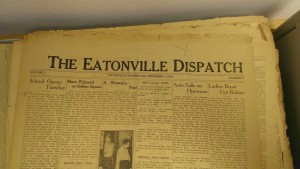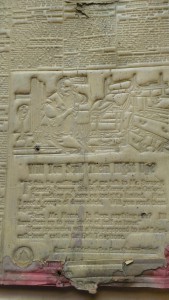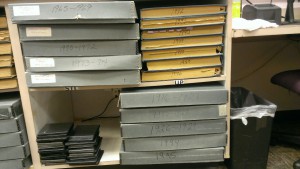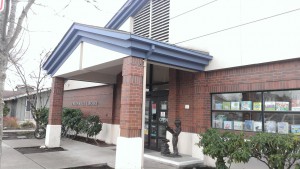From the desk of Shawn Schollmeyer & Washington Digital Newspapers.
 Though the Eatonville Dispatch began as a weekly newspaper in 1893, known available issues begin in 1916, stored on microfilm and carefully protected print copies in archival boxes located at the Eatonville Public Library. It’s still a weekly publication, now known as the Dispatch, printed and available online by the Pacific Publishing Company . We first became aware of the interest in digitizing older issues of this paper when one of the long time publishing families contacted us through Cindy Dargan, managing librarian of the Eatonville Library, to ask how to go about this digitization project. Floyd Albert and Georgina Larkin ran the paper from 1950-1962 and then brought in their son, Floyd Ames, who ran it with his mom until the early 1970s. Last year in 2014, the family decided that the best use of remaining estate money from those publishing years would be best spent converting the full run of the paper to a digital collection and displayed to the public.
Though the Eatonville Dispatch began as a weekly newspaper in 1893, known available issues begin in 1916, stored on microfilm and carefully protected print copies in archival boxes located at the Eatonville Public Library. It’s still a weekly publication, now known as the Dispatch, printed and available online by the Pacific Publishing Company . We first became aware of the interest in digitizing older issues of this paper when one of the long time publishing families contacted us through Cindy Dargan, managing librarian of the Eatonville Library, to ask how to go about this digitization project. Floyd Albert and Georgina Larkin ran the paper from 1950-1962 and then brought in their son, Floyd Ames, who ran it with his mom until the early 1970s. Last year in 2014, the family decided that the best use of remaining estate money from those publishing years would be best spent converting the full run of the paper to a digital collection and displayed to the public.
It’s a great idea and Floyd Ames’ brother, Bob Larkin, initiated the move to make it happen. Now, the first challenge begins. After 1922 all public works fall under copyright protection and all the publishers and descendants of the publishing families will need to be contacted for permission to scan and display the newspaper pages they published over certain dates. There were 12 different publishers between 1893 and 2010. Where are they now? Who can still be contacted if they have passed away? Where do we start?
The process of “discovery” began with a few trips to Pierce County libraries to determine the condition, format and completeness of the collection. My first stop at the South Hill Library branch revealed a beautiful, neat and clean building, but with the construction dust and disruption of the re-model, they decided to store the microfilm at the Lakewood branch, the largest branch in the Pierce County system which had more room to hold the film. Since I had just come from that area a visit would have to wait till the next day. So, a further excursion down Hwy 161 to meet Cindy at the Eatonville Library would reveal the carefully saved issues of the original print. As I gingerly handled the crumbling pages of the earliest issues in a nearby room, I could hear the library staff connect with their patrons. “Aren’t you supposed to be in school today? Oh, it’s in-service day.” Two grade school boys giggled from the nearby computers where they were engaged in a game. “I saw your Mom in the grocery store last week. I haven’t seen her in a while, glad she’s doing better” was directed to another patron. It was a busy day at the library in Eatonville and the staff is obviously an important part of that community.
 While checking for condition, missing issues and pages I found some other interesting artifacts of a bygone newspaper era. A princess from the Middle East came to visit Eatonville in 1917. An early pioneer, born in the 1880s and a well known citizen in town had just passed away in the early ‘20s. And what is this in the bottom of the box? Thick, pulpy printing mats embossed with text and ads from the Tacoma Daily Ledger, February 2, 1913, which were originally used on rotary printers for fast production of the daily paper. An early Bell Telephone ad, pictured here, states “Will You Send Them Right Up?” as the man pictured makes a quick call for shirts before he leaves on the evening train. A few of these old print mats from the rotary printing days had been stashed in the archival boxes as a nod to a by-gone era.
While checking for condition, missing issues and pages I found some other interesting artifacts of a bygone newspaper era. A princess from the Middle East came to visit Eatonville in 1917. An early pioneer, born in the 1880s and a well known citizen in town had just passed away in the early ‘20s. And what is this in the bottom of the box? Thick, pulpy printing mats embossed with text and ads from the Tacoma Daily Ledger, February 2, 1913, which were originally used on rotary printers for fast production of the daily paper. An early Bell Telephone ad, pictured here, states “Will You Send Them Right Up?” as the man pictured makes a quick call for shirts before he leaves on the evening train. A few of these old print mats from the rotary printing days had been stashed in the archival boxes as a nod to a by-gone era.
But there are also missing artifacts…. Where are some of the issues from the WWI and WWII? More sleuthing will be needed to track down pages that were filled with draft notices, war news and return heroes. More attempts to track down missing pages leads to yet another trip. A short visit to the busy Lakewood library, a two story, urban branch filled with computer users, parents and children. The helpful staff had not unboxed all the South Hill microfilm yet, but made and extra effort to search for the Eatonville film, but they didn’t have the missing issues we were seeking. Off to the University of Washington (UW) to see what they might have in their collection to fill in the gaps.
A visit to the UW campus on a sunny day is always a treat. Even in February there are camellias and hellebore blooming outside the stately Suzzallo Library. Inside the MicNews department, filled with six-foot-plus tall horizontal sliding walls of microfilm and many rows of newspaper racks I grabbed a few film reels for more review. Yep, I found a few of the missing date ranges that we will need and UW has a large collection of master film negatives, our preferred format for scanning. We partnered with UW and made use of their great collection during our participation in the National Digital Newspaper Program. It’s great news for us that we can work with them again on our new project.
 There are still a few challenges yet to solve to make sure that we have the most complete, fully searchable, and clean digital collection. Choosing the best scanning vendors for a reasonable price; pursuing a few more elusive issues; finding the descendants of the early publishers. All are important details that will need to be addressed before scanning and generating files and sharing them with the world.
There are still a few challenges yet to solve to make sure that we have the most complete, fully searchable, and clean digital collection. Choosing the best scanning vendors for a reasonable price; pursuing a few more elusive issues; finding the descendants of the early publishers. All are important details that will need to be addressed before scanning and generating files and sharing them with the world.
Over the next few months, Bob Larkin will be helping us to track down permissions to digitize from fellow publishers; we’ll be working with imaging vendors to scan as many pages this year as we can; and then we’ll be partnering with University of California, Riverside to add page numbers, dates, OCR and essential metadata, using the latest newspaper digitization software to make the collection compatible with national standards.
As you can see, there are many steps to wrangling a detailed project such as this, but also a satisfying job to bring this treasure to the world of the internet. Take a look at our online newspaper collection to-date from across the state: .






